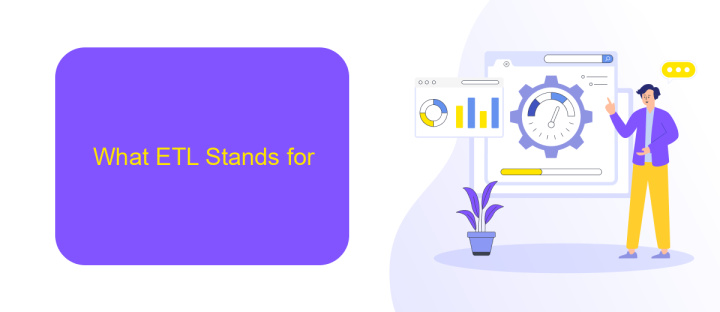What Does ETL Stand for in Data
ETL stands for Extract, Transform, Load, and it is a crucial process in data management and analytics. ETL involves extracting data from various sources, transforming it into a suitable format, and loading it into a destination system, such as a data warehouse. This process ensures that data is accurate, consistent, and ready for analysis, enabling better decision-making and insights.
Introduction
In the realm of data management, ETL stands for Extract, Transform, Load. This process is fundamental for businesses to consolidate data from various sources, convert it into a usable format, and load it into a data warehouse or other storage systems. ETL is essential for ensuring data integrity, consistency, and accessibility, making it a cornerstone of data-driven decision-making.
- Extract: This phase involves retrieving raw data from diverse sources such as databases, APIs, and flat files.
- Transform: The extracted data is then cleaned, enriched, and formatted to meet business requirements.
- Load: Finally, the transformed data is loaded into a target system, such as a data warehouse, for analysis and reporting.
Modern ETL tools and services, like ApiX-Drive, simplify the integration process by automating data workflows. ApiX-Drive enables seamless connections between various applications and data sources, ensuring that businesses can efficiently manage and utilize their data. This automation not only saves time but also minimizes the risk of errors, enhancing the overall quality and reliability of the data.
What ETL Stands for

ETL stands for Extract, Transform, Load, which are the three fundamental steps in the data integration process. Extraction involves retrieving data from various sources such as databases, APIs, and flat files. This data is often in different formats and structures, making it necessary to bring it into a unified form for further processing.
Transformation is the next step, where the extracted data is cleaned, enriched, and converted into a suitable format for analysis. This step may involve filtering out irrelevant information, aggregating data, and applying business rules. Finally, the Load phase involves transferring the transformed data into a target system, such as a data warehouse or data lake, where it can be accessed for reporting and analysis. Tools like ApiX-Drive can simplify the ETL process by automating data extraction, transformation, and loading, ensuring seamless integration across various platforms.
ETL Process

The ETL process, which stands for Extract, Transform, Load, is a fundamental concept in data management and integration. It involves extracting data from various sources, transforming it into a suitable format, and loading it into a target database or data warehouse. This process ensures that data is accurate, consistent, and ready for analysis.
- Extract: The first step involves extracting raw data from different sources such as databases, APIs, and files. Tools like ApiX-Drive can simplify this step by automating the extraction process from multiple platforms.
- Transform: In this step, the extracted data is cleaned, formatted, and transformed to meet the requirements of the target system. This may include data normalization, deduplication, and enrichment.
- Load: The final step involves loading the transformed data into a target system, such as a data warehouse or database, where it can be accessed for reporting and analysis.
By following the ETL process, organizations can ensure that their data is reliable and ready for use in decision-making processes. Utilizing services like ApiX-Drive can further streamline and automate the ETL process, making it more efficient and less prone to errors.
Benefits of ETL

ETL (Extract, Transform, Load) processes offer numerous benefits for businesses dealing with large volumes of data. By automating data extraction from multiple sources, transforming it into a consistent format, and loading it into a data warehouse, organizations can streamline their data management operations.
One of the primary advantages of ETL is improved data quality. Through the transformation phase, data is cleansed, filtered, and validated, which ensures that only accurate and relevant information is loaded into the target system. This leads to better decision-making and more reliable analytics.
- Enhanced data integration from various sources
- Improved data quality and consistency
- Time-saving through automation
- Scalability to handle growing data volumes
- Better compliance with data governance standards
Moreover, services like ApiX-Drive can further simplify the ETL process by providing easy-to-use tools for setting up integrations. ApiX-Drive enables seamless data flows between different applications, reducing the need for manual intervention and ensuring that your data pipeline remains efficient and reliable.


Conclusion
In conclusion, ETL (Extract, Transform, Load) is a fundamental process in data management and analytics. It enables organizations to gather data from multiple sources, transform it into meaningful information, and load it into a centralized system for analysis. This process is crucial for making informed business decisions and gaining insights from large volumes of data.
With the advent of advanced tools and services like ApiX-Drive, setting up ETL processes has become more streamlined and efficient. ApiX-Drive offers seamless integration capabilities, allowing businesses to automate data workflows without extensive technical expertise. By leveraging such platforms, organizations can focus more on data analysis and strategic planning, rather than the complexities of data integration. As data continues to grow in volume and complexity, efficient ETL processes will remain essential for harnessing its full potential.
FAQ
What does ETL stand for in data?
Why is ETL important in data processing?
What are the main steps involved in the ETL process?
Can ETL processes be automated?
What are some common challenges in ETL?
Apix-Drive is a simple and efficient system connector that will help you automate routine tasks and optimize business processes. You can save time and money, direct these resources to more important purposes. Test ApiX-Drive and make sure that this tool will relieve your employees and after 5 minutes of settings your business will start working faster.

